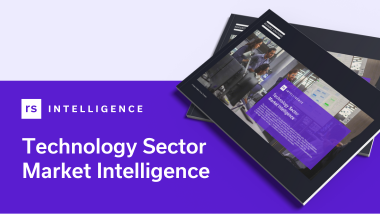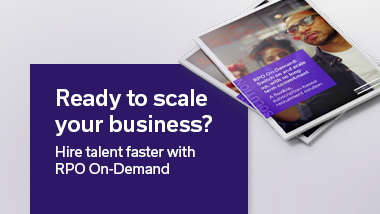A mid-size mindset: Stay agile with a short-term hiring strategy
HR leaders working at global giants should review their workforce solutions strategies with the mindset of their mid-market counterparts in order to remain agile, rather than fragile, in today’s ever-evolving recruitment market.
More established than a start-up, yet without the restrictions that a large enterprise organization can face, the mid-sized organization is the unassuming sleeper helping to prop up our workforce. This business group, comprised of companies with 5,000 to 15,000 employees, has been experiencing success despite the economic and labor market challenges we’ve seen over the past few years. Yet these companies are often overlooked in the grand landscape – a dynamic reminiscent of middle child syndrome. In fact, middle market companies account for one-third of employment in the US and one third of the country’s gross domestic product (GDP), so it’s arguably time to realign our thinking to their growth trajectory and talent requirements.
While the National Center for the Middle Market noted that growth has slowed since a sharp incline in 2020, mid-market companies still showed “record-level year-over-year revenue and employment growth” halfway through 2022. A recent drop in consumer confidence levels is a concerning sign of a down market, yet despite this revelation, 79% of companies at the mid-market level report increased revenue over the past 12 months and 58% of companies increased their workforces from 2021 to 2022.
However, this begs the question: how long will it last?
Middle-market leaders are confident this growth is sustainable. The same NCMM report noted that they expect continued growth over the next 12 months. That’s great news, especially with news breaking of our largest global firms experiencing lay-offs and downsizing. Are these announcements a true indicator of a contracting economy on the horizon? Or is it a natural result of growing too big and too fast during a time of global volatility, triggered by a health crisis, followed by supply chain disruptions and record-breaking inflation? Whatever the case, it’s time to review and optimise workforce strategies.
Don’t plan too far ahead
Today, there is a strong case to be made for why leaders should focus on one-to-two years hiring strategies rather than what their company will look like five years from now. Especially considering the changes to the traditional in-office work environment, the reduction in employment tenure, the welcoming of new workforce generations, and the shift in employee expectations, which must be reflected in every company’s employee value proposition (EVP).
Ironically, the key to stabilization is fluidity and flexibility, particularly as it applies to talent acquisition strategies, and today’s middle-market companies are in a unique position of flexibility. Due to its size, a mid-market company can pivot more quickly in a less stable environment, adopting a flexible approach within a compressed timeline towards their recruiting efforts.
4 ways to refocus your planning
Tap into project RPO
By securing talent when you need it, you can plan to use shorter intervals and scale up or down for workforce needs according to different variables, including seasonal and project-based hiring. With the hyper-digitalization that occurred during the pandemic to bring business online, companies of every size needed tech experts quickly. As the online business world continues to grow, additional expertise may be needed, but we don’t always know for what, by who, and for how long. An RPO provider that adapts to those unforeseen requirements – without the heavy price tag and long contract of a full workforce solutions program – is more in line with what the mid-market customer needs.
In her recent podcast, Kristin Thomas, President of North America, Resource Solutions, reiterated this point, noting that mid-level companies – and many other companies for that matter – may not anticipate their workforce needs so far into the future that it warrants a long-term and costly solution. Project-based and augmented RPO solutions can be the answer to planning in the short-term without losing quality of talent or time.
Take advantage of remote work
Historically, mid-level companies were often constrained by a smaller geographical radius to source talent. With the growth of remote and hybrid work, their talent pipelines have now been exponentially expanded.
In a middle-market company, hybrid work policies are often easier to implement because the scale is smaller and they don’t run into the issues that larger organizations tend to face, like deciding who qualifies for remote work and who doesn’t, consolidating brick-and-mortar sites, etc. There are several types of remote working models with differing advantages, disadvantages and best practices, it can be hard to choose, but there is plenty of advice on how to successfully implement the model that works best for your organization. While remote work might seem scary as it raises questions about compliance, payroll and tax details, an RPO provider securing remote talent mitigates those risks as they are in-the-know on all the most current employment mandates.
Stay in touch with employee sentiment
Mid-sized companies have the advantage of being closer to their employees, with mid-sized company leaders and stakeholders having a shorter direct line to employee sentiment. This allows those leaders to closely align their recruiting and retention strategies with what their workforce values – and they can more quickly adapt a plan in the short-term to accommodate changes in those sentiments when they are planning only one to two years out. The pandemic was a perfect example of being able to switch gears quickly to address the most immediate needs of a team – if you had to wait on a five-year plan to materialize, critical changes and accommodations for the workforce would have never come to fruition.
Base seasonal workforce planning on demand
Mid-level companies have a closer connection to their customers and the local market. This information can be used accordingly in shorter planning intervals to staff up or down. By anticipating consumer trends and their effect on a company’s products and services, mid-sized companies should have a flexible plan that addresses the immediate future talent needed for optimal operations. Project RPO is an ideal solution for this space, including such benefits as...
- Flexible and scalable delivery team, deployed within weeks
- Expertise across a wide array of roles and disciplines
- Connect with high-quality and niche professionals faster
If you envision a main plan that covers a one-year workforce strategy, with subsets of seasonality structured into it, a mid-level company will be able to deliver faster and more effectively, now that their talent provider is looking at shorter data cycles.
A fluid, talent acquisition strategy that plans for a shorter (often moving) timeframe simply makes sense. If you look at a snapshot of the economy and the world of work from just 2020 through to mid-way 2022, long-term strategies went by the wayside overnight, in lieu of emergency-preparedness and crisis plans. Smart companies who thrived were able to adjust on the fly and work within the confines of near-daily change with no real blueprint of what was unfolding in the labor market and the economy overall.
Mid-market companies, which inherently have a little bit more wiggle room to change course quickly, should embrace a recruitment process that adjusts in shorter spurts, while also keeping an eye on the horizon and remaining mindful of the big picture.













